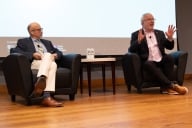You have /5 articles left.
Sign up for a free account or log in.
Career Education Corp. has begun one of higher education’s broadest experiments with adaptive learning. Institutions in the for-profit chain have powered more than 300 online course sections with the emerging technology, and enrollments in those courses have topped 11,000 students.
Broadly defined, adaptive learning is the use of data-driven tools to design coursework that responds to individual students’ abilities. Courses featuring adaptive technology typically use assessments to constantly adjust content, giving students extra help to master concepts or to skip ones they already understand.
"You can’t fool the engine,” Judy Komar, vice president for education technology at Career Education, says of her company’s approach. “There is that consistent demonstration of knowledge, and it’s in real time.”
So far all the courses in the project have been fully online. But the company is working on hybrid versions that use adaptive learning, which it hopes to roll out later this year.
Many in higher education think adaptive technology has the potential to help students learn more efficiently. Individualized course content can lead to both automated and professor-led interventions with students. That in turn can lead to improved completion rates.
For example, American InterContinental University, which Career Education owns, saw a 13.6 percent decline in student withdrawals in a pilot group taking adaptive-powered English composition and mathematics courses. Student persistence was up 4 percent, and students scored 6.8 percent better in the final course score.
Yet despite its promise -- and plenty of hype -- adaptive learning hasn’t exactly taken off in the academy. Some colleges have given it a go, perhaps most notably Arizona State University through its partnership with Knewton. But experts say the technology’s broader spread has been fitful.
Part of the reason is that some educators approach adaptive learning with wariness, in part over fears that it favors software over faculty members. But officials at Career Education said they see the technology as a tool for professors to use, rather than a way to replace them.
A complicating factor is the bewildering range of adaptive offerings from vendors. Given the complexity of the technology, it can be tough for college leaders to get past sales pitches to understand how they might incorporate adaptive learning.
“The word ‘adaptive’ has acquired a frisson,” says David Collery, managing director of CCKF Inc., an Ireland-based company that is working on the project with Career Education. “Adaptive seems to mean an awful lot of different things to an awful lot of different people.”
The Bill & Melinda Gates Foundation recently stepped in to try to help cut through the clutter. The foundation is in the process of awarding grants to 18 institutions that are using 10 different adaptive platforms. The grants are designed to encourage research on what works with each experiment.
“A lot of the action is happening at for-profits."
--Peter Stokes, executive director of postsecondary innovation, Northeastern University
Career Education has quickly become a player in the field. One key to being successful, company officials say, was to go big. And that’s something a for-profit chain can do well, even when many are struggling with declining enrollments and profits.
One Year In
The adaptive tool that CCKF and Career Education built is “content agnostic,” meaning it is not tied down to specific courses. Instead the company's adaptive-powered “learning maps” can stretch across multiple courses, academic programs and even multiple institutions.
Career Education’s initial pilot, launched last fall, involved 1,500 students at both its Colorado Technical University and American InterContinental University. The courses that got the treatment with a tailored version of CCKF’s Realizeit platform included English composition, mathematics, accounting and business management.
The early returns were promising, the company says. Students showed improved engagement, retention rates and grades in the pilot. So Career Education announced today that it is now integrating an adaptive learning platform, which is dubbed Intellipath, across curriculums at other institutions it owns, including Sanford-Brown and Le Cordon Bleu.
“This revolutionizes the field of education and the art of teaching,” says Diane Auer Jones, the company’s vice president of external and regulatory affairs. “We’re in it for the long haul.”
For-profits may bring a few advantages to the table when it comes to experimenting with some hot ideas in higher education.
The big chains were among the pioneers of online learning. The University of Phoenix and others got there early in part because of their large scale and ability to throw money at promising approaches. These days, in addition to Career Education’s adaptive learning project, Kaplan University is working on how to add game theory and digital badges to its course offerings.
Peter Stokes is executive director of postsecondary innovation in the College of Professional Studies at Northeastern University. He has written about adaptive learning, and thinks it has the potential to be used across much of higher education.
However, Stokes said the technology is particularly valuable for colleges that are concerned about boosting their student success rates, at least at this stage in the game.
“A lot of the action is happening at for-profits,” says Stokes, “and also at community colleges.”
Informed Students and Professors
Nontraditional and disadvantaged students are a big part of the mix at institutions that received Gates’s adaptive learning grants, says Rahim Rajan, a program officer at the foundation. About 44 percent of overall enrollment at those colleges and universities are eligible to receive Pell Grants.
Jones, a former official in George W. Bush’s Education Department, says her company’s scale and longtime focus on technology helped it to move fast on adaptive learning. But she says Career Education didn’t force the new approach on its largely autonomous institutions.
“The pace can only go as fast as faculty are willing to engage,” she says.
Even so, Career Education lacks the strong faculty governance role of a traditional college. And the company didn’t need to negotiate with a faculty union, because it doesn’t have one.
Two professors at Colorado Technical University said in an interview that they participated in the early stage of the adaptive pilot. They say faculty members designed the content that became “nodes” in adaptive learning courses. The learning nodes revolve around concepts, much as in competency-based education.
“You can’t fool the engine.” -- Judy Komar, vice president for education technology at Career Education
In an algebra course at the university, for example, there are 125 nodes and 3,200 assessment questions.
“By definition it’s tailored to the students,” says Timothy Gleason, an assistant professor of English and history at Colorado Technical. “I’m seeing remarkable results.”
At the beginning of each week during an online course, students in Career Education’s adaptive courses take an assessment to see where they stand. The quick test, which can be completed in less than 30 minutes, shows what they already know in a particular unit and what they still need to learn.
That assessment and more throughout the week are used to tweak course content, says Komar.
That means the software adjusts based on how students perform. It also helps professors learn how to change their teaching approach. The technology gathers data about the class and individual students, which is then sent to professors as “analytical dashboards.” Faculty members can use the dashboards to decide which material to emphasize in class.
“We have the most informed students and faculty that we’ve ever had,” Komar says.
Steve Ryan, an adjunct professor of English at Colorado Technical, said the real-time updates of students’ strengths and weaknesses helped him adjust his teaching strategy. But just as importantly, he says the technology encouraged students to be more active participants.
In the third week of the English course he taught as part of the pilot, Ryan says the “class just took off.” Students were more engaged in discussions, he said, and checked in on coursework more often.
Jones says the project is relatively novel among other adaptive learning efforts in part because it extends to English courses with writing components. The more subjective nature of writing can be tricky to customize with automated tools -- more so than content for a math course.
Career Education is now branching out into more upper-division courses as part of the project, including statistics II and III.
“We are far beyond multiple choice tests,” Jones says.
Despite excitement about the technology at Career Education, officials and faculty members there say adaptive learning is no magic bullet. It offers promise for improving student success, they say, but will require constant tweaking as it is brought online.
“We’re still finding our sea legs,” Gleason says.








